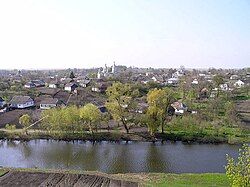Korets
Korets
Корець Korzec | |
|---|---|
 General view of Korets | |
| Coordinates: 50°37′02″N 27°10′39″E / 50.61722°N 27.17750°E | |
| Country | |
| Oblast | Rivne Oblast |
| Raion | Rivne Raion |
| Hromada | Korets urban hromada |
| First mentioned | 1150 |
| Population (2022) | |
• Total | 6,914 |
Korets (Ukrainian: Корець, IPA: [ˈkɔretsʲ]; Russian: Корец; Polish: Korzec; Yiddish: קאריץ Koritz) is a city in Rivne Oblast, Ukraine. The city is located on the Korchyk river, 66 kilometers to the east of Rivne. It was the administrative center of Korets Raion until the raion was abolished in 2020. Population: 6,914 (2022 estimate).[1]
History
[edit]Known since 1150 as Korchesk, Korets was fortified by Prince Theodor Ostrogski in the late 14th century. At that time, the town was part of the Grand Duchy of Lithuania.
Between the 15th and 17th centuries, the Korets Castle was the seat of the princely House of Korets that issued from Duke Narimantas of Volhynia. After the death of the last Prince Korecki in 1651, it passed through inheritance to the junior line of the House of Czartoryski and became its main seat until the line died out in the early 1800s.
Following the 1569 Union of Lublin, Korzec, as it was known in Polish, became part of the Kingdom of Poland, where it remained for over 200 years, administratively located in the Volhynian Voivodeship in the Lesser Poland Province, until the Partitions of Poland. The town then belonged to the Volhynian Governorate of the Russian Empire.

The Korzec porcelain plant was established by Józef Klemens Czartoryski in 1783. It was managed by French brothers Francois and Michel de Mezer of Sevres. Its products were famous across Poland. The plant burned in 1797, was rebuilt in 1800, and operated until 1832. Furthermore, Prince Jozef Czartoryski opened here a manufacturer of cloth sash, popular among Polish-Lithuanian szlachta.
At the end of the 19th century, 70 to 80% of the inhabitants were Jewish.[2]
In the Second Polish Republic, Korzec, as it was called, was part of Równe County, Volhynian Voivodeship. Most of its population was Jewish, with Polish and Ukrainian communities. In 1924, a local branch of the Polish Sokół movement was founded.[3]
Following the joint German-Soviet invasion of Poland, which started World War II in September 1939, the town was occupied by the Soviet Union until 1941, then by Germany until 1944, and then re-occupied by the Soviet Union, which eventually annexed it from Poland in 1945. A local newspaper has been published here since June 1941.[4]
Before World War II, 6,000 Jews lived in the town.[5] In May 1942, 2,200 Jews were murdered and survivors were kept prisoners in a ghetto. In September 1942, 1,500 Jews were murdered in a mass execution.[6] In the summer of 1943, local structures of the Home Army were destroyed by the Germans.
| Year | Pop. | ±% |
|---|---|---|
| 1989 | 9,437 | — |
| 2013 | 7,388 | −21.7% |
| Source: [7][8] | ||
Sights
[edit]Historical heritage of Korets includes the remains of its old castle and Resurrection Monastery, as well as the Church of St. Antony (1533, rebuilt 1706 and 1916) and Trinity Church (1620). St. Antony church was used during part of the communist time as a chemical storage facility. Upon the arrival of the catholic pater Jozef Kozlowski in 1994, this church was gradually refurbished and eventually brought back to its original form, both internally and externally. Pater Kozlowski was priest and caretaker of St. Antony church until year 2002.
Gallery
[edit]-
Main square of Korets
-
Church of St. Anthony
-
Ruins of Korets Castle
-
Holy Trinity Monastery
Notable people
[edit]- Yaroslav Alexandrovich Evdokimov (Євдокимов Ярослав Олександрович – ukr., born 22 November 1946) is a singer, baritone, Honored Artist of the Russian Federation and People's Artist of Belarus. After high school, despite his innate talent, he studied at Vocational School of Korets (1964–1965 years), mastered the working specialty.[9]
- Rabbi Pinchas of Koretz, a famous Hasidic Rebbe, (1726–1791) is from the town.
- Rabbi Asher Zebi of Ostrowo.
- Oleksandr Yakymchuk
References
[edit]- ^ Чисельність наявного населення України на 1 січня 2022 [Number of Present Population of Ukraine, as of January 1, 2022] (PDF) (in Ukrainian and English). Kyiv: State Statistics Service of Ukraine. Archived (PDF) from the original on 4 July 2022.
- ^ "History - Jewish community before 1989 - Korzec - Virtual Shtetl". Archived from the original on 2 June 2016. Retrieved 5 May 2016.
- ^ Drozdek-Małolepsza, Teresa; Małolepszy, Eligiusz (2018). "Z dziejów Towarzystwa Gimnastycznego "Sokół" okręgu wołyńskiego (1922–1939)". Prace Naukowe Akademii im. Jana Długosza w Częstochowie. Kultura Fizyczna (in Polish). XVII (2). Częstochowa: 78. ISSN 1895-8680.
- ^ № 3082. «Октябрьские зори» // Летопись периодических и продолжающихся изданий СССР 1986—1990. Часть 2. Газеты. М., «Книжная палата», 1994. стр.403
- ^ "AfterMarket.pl :: Domain moreshet.pl". Archived from the original on 26 October 2015. Retrieved 5 May 2016.
- ^ "המכון הבין-לאומי לחקר השואה - יד ושם".
- ^ Всесоюзная перепись населения 1989 г. Численность городского населения союзных республик, их территориальных единиц, городских поселений и городских районов по полу
- ^ "Чисельність наявного населення України на 1 січня 2013 року. Державна служба статистики України. Київ, 2013. стор.91" (PDF). Archived from the original (PDF) on 12 October 2013. Retrieved 16 July 2019.
- ^ Наші випускники
Further reading
[edit]- Weiner, Miriam; Ukrainian State Archives (in cooperation with); Moldovan State Archives (in cooperation with) (1999). "Town Clips: Korets." Jewish Roots in Ukraine and Moldova: Pages from the Past and Archival Inventories . Secaucus, NJ: Miriam Weiner Routes to Roots Foundation. p. 414. ISBY 978-0-96-565081-6. OCLC 607423469.
External links
[edit]- Korets (pp. 414) at Miriam Weiner's Routes to Roots Foundation.
This article needs additional citations for verification. (February 2015) |







